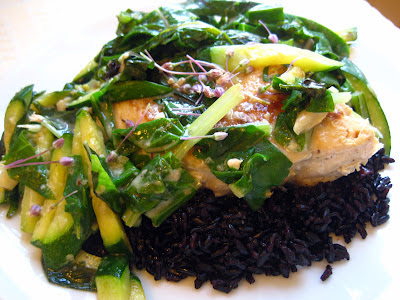Ingredients
Olive oil
8-10 oz moonfish (opah) or another fatty, mild white fish
Salt and freshly ground black pepper
1 small zucchini, sliced lengthwise into thirds and then cut crosswise into strips
1 tbsp grated fresh ginger
1 clove garlic, sliced
15 fresh basil leaves
2 handfuls young chard, beet greens, or spinach, sliced crosswise into ribbons
5-6 oz light coconut milk
1 tsp onion blossoms or one scallion, white and light green parts, thinly sliced
Rub each side of the fish with a pinch of ginger, and sprinkle both sides with salt and pepper. (You can cut it into cubes or leave it as a whole steak—whichever you prefer. Cubes will cook much more quickly, and will retain less of their own moisture but absorb more of the sauce. We left ours whole, just because it's easier.)
 Heat a glug of olive oil in a large nonstick frying pan over medium heat. When hot, add the zucchini and stir a few times, then saute, stirring once or twice a minute, until it starts to turn golden brown in a few places. Add the garlic and a pinch of ginger and saute for a minute more, then add the basil leaves and saute for 10 seconds or until they have just wilted. Decant into a bowl and set aside.
Heat a glug of olive oil in a large nonstick frying pan over medium heat. When hot, add the zucchini and stir a few times, then saute, stirring once or twice a minute, until it starts to turn golden brown in a few places. Add the garlic and a pinch of ginger and saute for a minute more, then add the basil leaves and saute for 10 seconds or until they have just wilted. Decant into a bowl and set aside.Replace the pan over the heat and add another glug of olive oil. Add the fish and cook, shaking the pan occasionally, until golden brown on the bottom, then flip and cook the other side until golden as well (if your fish is cubed, just brown one side and then skip to the next step).
 Add the greens to the pan, sprinkle them with salt, and pour the coconut milk over the top of everything. Cover immediately, turn the heat down to medium-low, and steam for a minute or so until the greens start to wilt.
Add the greens to the pan, sprinkle them with salt, and pour the coconut milk over the top of everything. Cover immediately, turn the heat down to medium-low, and steam for a minute or so until the greens start to wilt.Uncover the pan, scatter the ginger over the greens, and stir to combine. Replace the cover and simmer until the fish is very nearly cooked through. (I can't tell with moonfish unless I cut it in half at some point to see how pink it still is in the middle, which is the other reason I like leaving it as one whole piece to start with...I end up cutting it in half or quarters by the time I'm done checking it.)
Add the zucchini back into the pan, sprinkle with the onion blossoms or scallion, and cook for about 30 seconds to reheat, stirring occasionally. Remove from the heat, and serve immediately over rice.
Serves 2.































